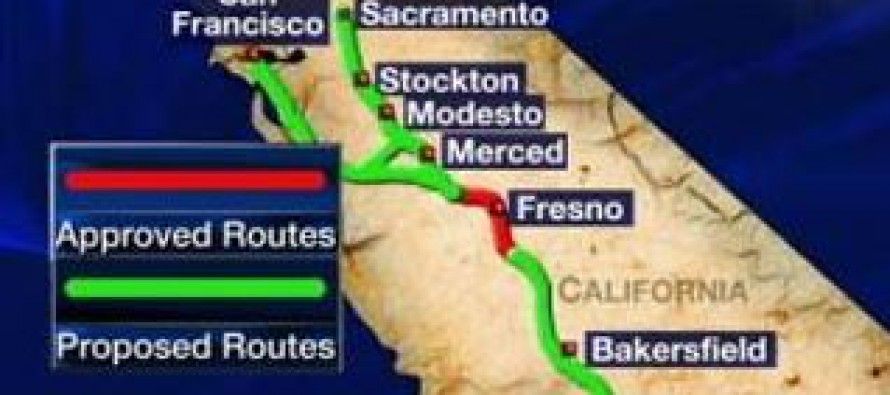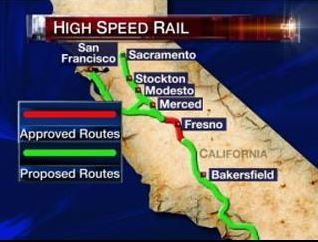Ruling that CA high court upheld hardly favorable to bullet train

 I talked to a couple of insider types Thursday who asked me to explain my take on Wednesday’s California Supreme Court announcement on the bullet train. After all that’s gone down, they couldn’t believe that the justices would clear the way for the state to begin selling bonds for the $68 billion boondoggle, and that’s what they were reading in AP and the L.A. Times.
I talked to a couple of insider types Thursday who asked me to explain my take on Wednesday’s California Supreme Court announcement on the bullet train. After all that’s gone down, they couldn’t believe that the justices would clear the way for the state to begin selling bonds for the $68 billion boondoggle, and that’s what they were reading in AP and the L.A. Times.
They were right to wonder about the MSM coverage. The state Supreme Court declined to review a state appellate court ruling that said Sacramento Superior Court Judge Michael Kenny was wrong to block bond sales in his November 2013 decision on the project.
But in the big picture, the appeals court ruling that the state high court upheld is hardly favorable to the state government or the bullet train:
The appeals court that vacated … Kenny’s ruling to block the project did not say that Kenny’s conclusion that the HSRA violated Proposition 1A was wrong. Instead, the decision held that a trial judge had no authority to block construction until the legislature and the High Speed Rail Authority approved a final business plan.
“The scope of our decision is quite narrow,” the judges wrote in the first paragraph.
The decision went on to reinforce two key protections contained in Proposition 1A — both meant to ensure that the state didn’t spend billions on initial construction only to run out of money before a financially viable train system could be built. Judge Kenny ruled that the state had to identify “sources of funds that were more than theoretically possible” in explaining how it would pay for the project’s $31 billion, 300-mile initial operating segment. He also said that the HSRA had to complete environmental reviews for the entire segment before construction could begin. The appeals court contradicted him on neither point.
The appellate court underscored that the law requires the state to establish “financial viability” for the bullet train’s first segment by adhering to a voter-approved “financial straitjacket.” It said that bond funds could only be spent after a funding plan gained approvals from the state finance department, the Joint Legislative Budget Committee, and an independent financial analyst who certified the plan’s soundness — specifically that if built as planned, the bullet train could operate without a taxpayer subsidy. The appeals court judges also agreed with Judge Kenny that the rail authority had to obtain “all the requisite environmental clearances before construction begins.”
These are shortcomings that [the state of California] cannot easily finesse.
That’s from a City Journal piece I wrote last month.
Money isn’t coming from state, feds or contractors
 I got a little pushback on the assertion that the environmental clearances requirement can’t be finessed from those who see the state’s establishment as so corrupt that some judge somewhere can be persuaded to go along with sham claims from the state. But I don’t think it will be that easy. Environmentalists will freak out if the California Environmental Quality Act is sidestepped on a big project because of the precedent it would set. Powerful greens and groups like the Sierra Club and the NRDC like having CEQA be a powerful tool to block growth, and if the bullet train is collateral damage, so be it.
I got a little pushback on the assertion that the environmental clearances requirement can’t be finessed from those who see the state’s establishment as so corrupt that some judge somewhere can be persuaded to go along with sham claims from the state. But I don’t think it will be that easy. Environmentalists will freak out if the California Environmental Quality Act is sidestepped on a big project because of the precedent it would set. Powerful greens and groups like the Sierra Club and the NRDC like having CEQA be a powerful tool to block growth, and if the bullet train is collateral damage, so be it.
But I got no credible pushback and really never have on my assertion that the $25 billion or so funding shortfall for construction of the initial $31 billion, 300-mile segment cannot be finessed. That’s just too much of a gap.
The slice of cap-and-trade revenue going to the bullet train is so small compared with the project’s overall budget needs that Associated Press called it “symbolic.” The federal government isn’t going to pay for California’s project in an era in which domestic discretionary spending is the no. 1 target of budget hawks in both parties. And while rail authority board chair Dan Richard may have convinced James Fallows and one naive state reporter that bullet train contractors are bullet train investors, that claim is laughable.
I invite Richard or Fallows or anyone to show me a single bullet-train project anywhere in the world in which private investors were lured in without promises of minimum annual revenue or ridership.
They won’t because they can’t. And such guarantees are banned for the California bullet train under Proposition 1A, the 2008 state law approved by the voters giving the go-ahead to the bullet train project.
Will the state figure out a way to waste billions of dollars on a white elephant rail line in the Central Valley? Maybe.
But call me naive: I actually think that Proposition 1A’s safeguards will kick in and save the day — as soon as the rail authority, the Legislature and the Brown administration ratify a new business plan.
Related Articles
Political energy crisis in the making
June 9, 2013 By Katy Grimes With industrial electricity rates 88 percent higher in California than in Texas last year,
High-speed rail push leading to Nov slaughter?
July 5, 2012 By Katy Grimes Commentary This week could mark the last big, well-orchestrated push for high-speed rail. Think
Supreme Court has good news for CTA, CFT
A recent U.S. Supreme Court hearing on allegations of racial discrimination in Texas public housing programs may have major implications



